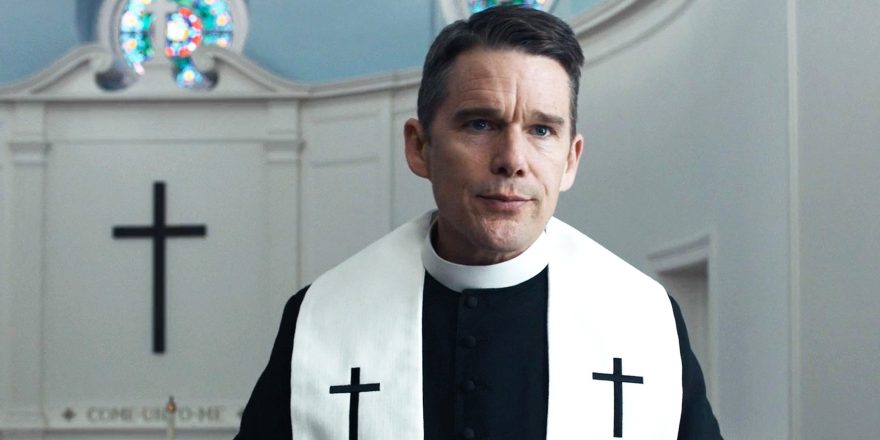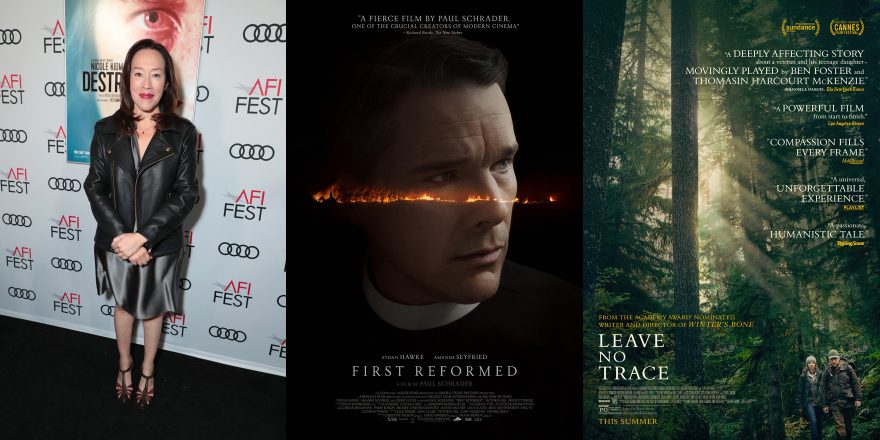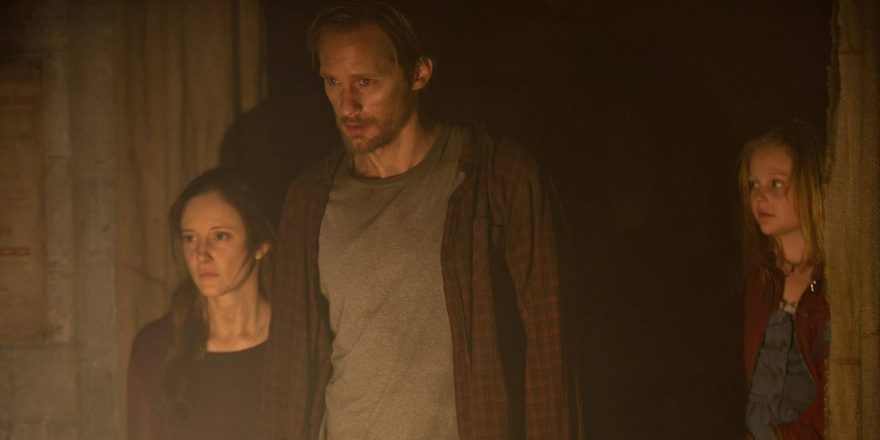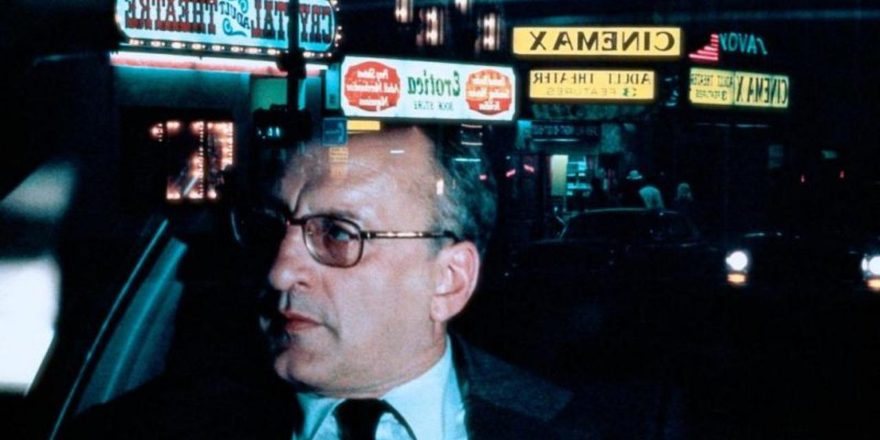Over the festive break, Talkhouse Film is revisiting some of its most read (or listened to) pieces of the year, including this one. Happy holidays! – N.D.
Writing on his indispensable and entertaining Facebook page, Paul Schrader recently outlined his perspective on the current nature of independent film sales, through his experience selling First Reformed in the fall of 2017:
“First Reformed was sold at a bargain price to A24 out of the Toronto FF. Netflix, which could have snapped it up as easily as it swats a fly on its ass, passed. As did Amazon. As did Sony Classics and Focus. But A24 saw a commercial path for this austere aesthetic film. As a result First Reformed found a life. A24 rolled it out through festivals and screenings from 2017 to 2018. And it survived. Not a big money maker but profitable for A24 and a jewel in their crown. Would First Reformed have found this public acceptance if Netflix [had] scooped it up (at say twice the price A24 payed) and dumped it into its larder? Perhaps Bird Box and Kissing Booth can fight their way through the vast sea of Netflix product to find popular acceptance, but First Reformed? Unlikely. Relegated to film esoterica.”
The above statement serves as a complete syllabus for understanding the current problem facing the sale of independent films and the financial realities involved therein. To begin with, there’s Schrader’s ominous reference to the “bargain price” that A24 purchased the movie for. First Reformed had a production budget of $3.5 million, according to remarks made by Schrader, including directly to me in an interview for Cinema Scope magazine. In that interview, Schrader called it a totally responsible budget, as he made the film at a cost guaranteed to give investors a return when it went to market.
This no doubt proved true, as likely robust foreign sales – after premieres at Venice, Telluride and Toronto – balanced out whatever reduced price was paid for domestic rights. (With absolutely no knowledge of the situation aside from having been in this position many times myself, I would guess the sale was somewhere between $500,000 and $1,000,000; though anything in that range exceeds what may be considered a “bargain,” it certainly seems one in relation to the film’s budget.)
Schrader’s revelation about the distributors that passed is deeply troubling when one considers the hypothetical outcomes that a film like First Reformed – which became an Oscar-nominated breakout hit – could have suffered. This information illuminates just how close every success story is to a tale of failure and oblivion. (He neglects to mention several comparable companies, namely Fox Searchlight, but one can infer that they probably passed as well.)
This illuminates the dire absurdity that the independent film distribution landscape, though operating with a handful of major players, basically resembles a two-party political system where choices are made to favor and push only a select few titles, and where outliers are unlikely to receive serious attention. Put it simply, it’s quite possible that 10 percent of independent films receive 90 percent of the sales money, press and thus revenue. This number may even be too high: it could be closer to 5 percent. An analysis of this would be most welcome.
Schrader’s point is that without A24 saying yes when (apparently) everybody else said no, First Reformed would not have enjoyed the 18-month victory march toward bountiful awards and accolades for himself and the film’s star, Ethan Hawke, culminating in Schrader’s first ever Oscar nomination. One more “no” and First Reformed would likely have been given a release somewhere between cursory and modest, made very little money, and have been an underrated favorite rather than the powerhouse it became.
He says that Netflix could have scooped it up and “dumped it into its larder,” but the same is true of any number of mid-size distributors who release far more product than the coveted and selective distributors he cites. To continue my above analogy, these companies function not as major political forces (like those listed by Schrader), but instead as third-party challengers who exist only to make a bit of noise and desperately try to attract attention away from the vastly more well-funded establishments they are up against.
First Reformed in the hands of this type of company would have been the blip that most of their releases end up being, and nothing resembling what A24 achieved with the film. I say this because the metrics of success for most companies are so low that victory can be measured by simply competing in the race, not placing and certainly not winning.
All this to say that a film at this budget level has a phenomenally slim chance of finding a home with one of the few companies able to offer anything other than immediate and devastating financial loss for a film’s investors. And I care about this because this is a budget level (let’s call it “under $5,000,000,” though realistically, I know of very, very few films of this sort that cost close to $5 million) where both longtime legends like Schrader and my friends and peers are able to achieve the most fully realized and uncompromised versions of their work. (For more in this category, I would cite movies like Good Time, The Florida Project and The Little Hours. It goes without saying that I do not know the exact budget of these films, but I know that they are uncompromised visions, and if they had higher budgets, they would have been subjected to compromise. This is how it works.)
So when you have the director of an Oscar-nominated film saying that the sale price was “a bargain” but that film was made for a relatively modest budget that is still larger than most filmmakers could dream of, there is a massive systemic rot at the core of the industry. Based on this model (and it cannot be overstated the extent to which sales and financing decisions are based only on a “model,” i.e. of a recent film that is either vaguely similar or not similar at all), a film with zero Oscar prospects that costs more than $3 million that may expect to sell for a “bargain” is suddenly a deeply undesirable film to finance. Thus, the film will never exist and somehow the success of First Reformed, however one quantifies it, may prevent a similarly singular and ambitious film from being made.
The message at the root of issues like this is that when it comes to the creation of a film – that is to say, the pitching and financing of it – the cart must come before the horse. Meaning, premiering and selling the movie is at the forefront of every conversation from the moment people read a script. If there isn’t an overwhelming possibility that the unveiling of the film will result in robust financial reward, the script may never become a film. However, anybody who has been through this will know, as Schrader explains, that the value of a film essentially crashes from “infinite” in the hours before anybody gets to see it to “we will take what we can get” about 48 hours later.
The fact is, nobody would finance a film if they do not reasonably expect to sell the film for extremely close to whatever the budget was. Forget about the theoretical “commercial prospects” for a second, because unless films end up with one of the distributors Schrader lists, those prospects go from “a decently performing art-house hit” (what Schrader calls “public acceptance”) to “absolutely nothing” (“relegated to film esoterica”). Even admirable efforts by independent-minded critics groups and awards programs tend to largely favor the two or three most successful films from the above-referenced group of big-deal distributors. Again: 5 percent of product/95 percent of oxygen.
One of the most irreparably destructive things to happen to the independent film market came and went without being justly commented on as the apocalyptic impact it had. I am referring to Amazon’s Festival Stars program, which offered a flat rate of $50,000-$100,000 for titles which premiered in a main section at either Sundance or SXSW to self-distribute on Amazon Video Direct. When this was introduced, there did seem to be a fair amount of eyebrow-raising. After all, it essentially created a false market price wherein the value of any film, regardless of budget, was valued equally. And, worse, the value was at a price point that would cover a return of investment on the budget of almost no films that reached the level of prominence required to claim this bounty.
That amount of money would have changed the life of my and many of my friends had it been available to us when our films cost no more than $20,000. Offering that to films whose budgets may be in the high-six or low-seven-figure range all but guarantees that those involved lose their shirts. But what was worse was that it meant any distributor could come to a film with an offer of anything over $100,000 and know that, budget be damned, the filmmakers were in a position where they would be forced to accept. A $110,000 offer on a million-dollar film no longer had to worry about being the lowest; any product is only as valuable as the lowest anybody selling is willing to accept for it. In 2017, Amazon acquired FORTY movies out of South by Southwest, thus sending the message that if your movie cost more than $50,000 and it premiered there the following year, there was an overwhelming likelihood that you would lose a lot of money.
And then, weirdly, Amazon discontinued this program. After revaluing most films to “basically worthless,” they then decided it wouldn’t even be worth the nominal sums they were paying to acquire buckets of films wholesale and dump them onto what Schrader calls both a “larder” and a “vast sea.” According to a Variety article on the SXSW 2017 shopping spree, Amazon spent $1.9 million on 40 movies. At Sundance 2019, Amazon paid $41 million for five movies, spending $13 or 14 million each on three of those. Not being an economist, I am not qualified to analyze the ripple effects of value versus market cost implicit in this vast discrepancy, but there is a lesson to be learned here, and to me that lesson feels like, “Don’t play the game, because you will not win.”
What concerns me as a filmmaker who would like to find supportive budgets for increasingly ambitious projects (and would love to be one of many filmmakers receiving such an opportunity) is that the seesaw has rocked from, “Spend more than $50,000 and you will lose money” to, “You may make $13,000,000, but also you probably won’t and will lose money” and in both of these scenarios, people will be unwilling to finance or make most scripts into films because the risk is simply too tremendous to justify.
My new film, Her Smell, cost less than First Reformed. The crew pulled off miracles and executed things that most people couldn’t dream of affording for twice our budget. We were ruthlessly efficient and I got everything I needed to make the script exactly as I wanted. The film did not sell for $13 million but I remain optimistic that its distribution and release in no way runs the risk of being relegated to esoterica. However, I am sorry to say, to the next 10 filmmakers who have a comparable film at a comparable budget level, I don’t think I made it any easier for you to get your script produced. We are seemingly stuck in a situation befitting classic American ideals where the rich (i.e. easygoing, mass-market crowdpleasers that sell to Schrader’s target companies) benefit or profit the most, the poor (relatively or extremely inexpensive movies) can no longer survive or justifiably exist, and the middle class (movies like Her Smell or First Reformed) are threatened with extinction due to being potentially unsustainable. And if we are not creating a sustainable means of production and also a marketplace for those coming up behind, then I must worry about the future as much as I fret about the present.








